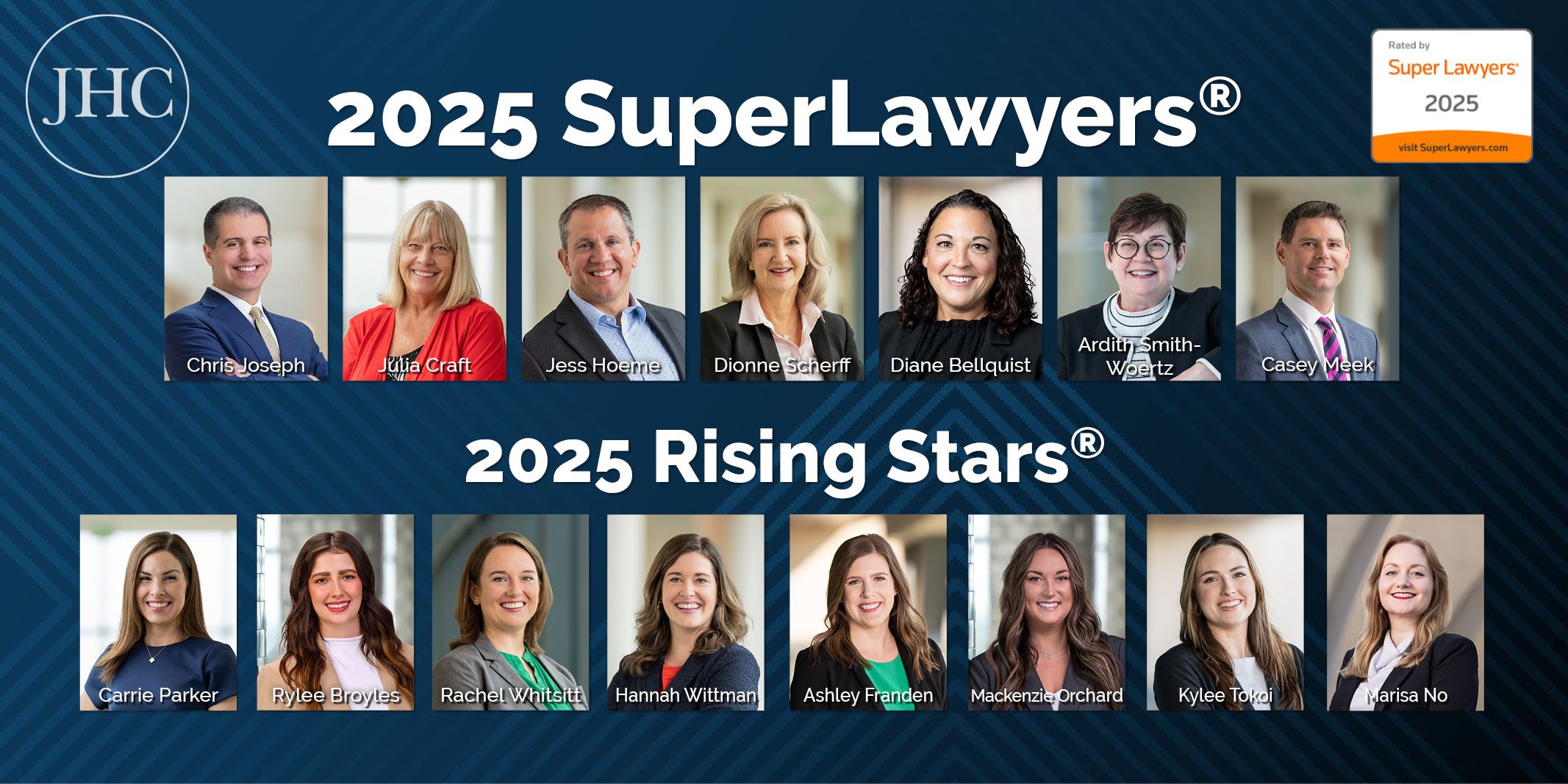LEGAL ETHICS & MALPRACTICE REPORTER
Vol 2. February 28, 2021 No. 2
TABLE OF CONTENTS
Featured Topic
Ethical Issues in Family Law
New Authority
ABA Formal Opinion 497
Tech Tip
Protecting Yourself from Yourself on Social Media
Ethics and Malpractice Research Tip
Resources on Legal Ethics and Family Law Practice
A Blast from the Past
An Excerpt from The Antiquary, Sir Walter Scott
EDITOR: Professor Mike Hoeflich
PUBLISHED BY: Joseph, Hollander & Craft LLC
FEATURED TOPIC
ETHICAL ISSUES IN FAMILY LAW
Rule 1.2 Scope of Representation by Katherine E.M. Chlumsky
From the first day of law school, we are taught that it is a lawyer’s duty to act in her client’s best interests. So, what is our duty when we cannot fathom our client’s interests will be served by the actions they desire?
Consider the following hypothetical: Your client, Party A, has received a settlement offer from Party B on the division of marital property. You, the attorney, explain to Party A all the reasons the settlement is reasonable and reflects how the court will likely divide the marital property. But Party A does not want accept the settlement offer because the offer does not allocate to Party A the moped the parties bought their son, Frank, in 1989. Party A really wants that moped. (Sidebar: Frank is now 40 and neither party rides the moped.) You again explain the benefits of the settlement, the risks associated with proceeding with an evidentiary hearing, and the costs that will accompany it. Party A is resolute about the moped and will not settle.
It is in the client’s best interest to settle. The court is likely going to award the moped to Party A’s soon-to-be-ex-spouse, and Party A could get a new moped without the hassle of litigation. So can you call opposing counsel and accept the offer? No. The Kansas Rules of Professional Conduct & Model Rules of Professional Conduct prohibit you from doing so.
KRPC Rule 1.2(a) states:
A lawyer shall abide by a client’s decisions concerning the lawful objectives of representation, subject to paragraphs (c), (d), and (e), and shall consult with the client as to the means which the lawyer shall choose to pursue. A lawyer shall abide by a client’s decision whether to settle a matter…
As explained further in the comment section, “the client has ultimate authority to determine the purposes to be served by legal representation.” KRPC 1.2, Comment 1. However, the comment elaborates:
Within those limits, a client also has a right to consult with the lawyer about the means to be used in pursuing those objectives. At the same time, a lawyer is not required to pursue objectives or employ means simply because a client may wish that the lawyer do so. A clear distinction between objectives and means sometimes cannot be drawn, and in many cases the client-lawyer relationship partakes of a joint undertaking. In questions of means, the lawyer should assume responsibility
for technical and legal tactical issues, but should defer to the client regarding such questions as the expense to be incurred and concern for third persons who might be adversely affected. Law defining the lawyer’s scope of authority in litigation varies among jurisdictions.
What this means in a practical sense is a little gray. An example of an attorney not pursuing an objective or a means would be not including an interrogatory in discovery about a prenuptial that was never prepared, let alone signed, but was discussed by the parties, according to your client. It is not relevant to the divorce and requesting it through discovery does not provide any benefit.
However, the rule itself acknowledges that not all objectives and means have clear distinctions and, in many cases, the client and lawyer need to be on the same page. Note 2 of the Model Rules offers that, if a client and attorney reach an impasse about a means or an objective, the attorney may withdraw from representation.
The ultimate takeaway is that, regardless of means or objectives, you need to communicate with your client. See Rule 1.4. In fact, in most of the disciplinary cases heard before the Kansas Supreme Court involving Rule 1.2, Rule 1.4 always accompanied that violation. See In re Johnson, 300 Kan. 851, 335 P.3d 634 (2014) (attorney dismissed client’s case without authority); In re Lampson, 282 Kan. 700, 147 P.3d 143 (2006) (0attorney failed to abide by client’s decisions regarding settlement and instead agree to terms directly contrary to her position); In re Wenger, 279 Kan. 895, 112 P.3d 199 (2005) (attorney failed to consult with client prior to sending a letter requesting parties engage in settlement talks).
Rule 1.7: Representing Both Parties in a Divorce Action by Rebecca F. Henry
Attorneys are often asked to represent both parties in a divorce action. It is not ethical to do so—primarily due to Rule of Professional Conduct 1.7, although Rule 1.4 and Rule 1.6 also play a role.
Rule 1.7 states:
(a) Except as provided in paragraph (b), a lawyer shall not represent a client if the representation involves a concurrent conflict of interest. A concurrent conflict of interest exists if: (1) the representation of one client will be directly adverse to another client; or (2) there is a significant risk that the representation of one or more clients will be materially limited by the lawyer’s responsibilities to another client, a former client or a third person or by a personal interest of the lawyer.
In a divorce action, the parties are directly adverse to one another. Therefore, 1.7(a)(1) instructs that representation of both parties to the divorce would create a concurrent conflict of interest. Even when the
parties believe the matter will be uncontested, there is always the possibility that one party changes their mind or an issue will arise that was not contemplated at the outset of the action. For this reason, the attorney cannot represent both parties in a divorce action.
Divorce attorneys must also consider Rule 1.6(a)’s restrictions on client confidentiality:
A lawyer shall not reveal information relating to the representation of a client unless the client gives informed consent, the disclosure is impliedly authorized in order to carry out the representation or the disclosure is permitted by paragraph (b).
This rule creates an ethical dilemma for an attorney when both clients are adverse to one another in a divorce action. As a divorce attorney, it is important to advise your client on all possibilities when discussing settlement or trial preparation. It would be difficult to have meaningful settlement negotiations with either client while maintaining confidentiality for both parties when discussing division of the same debts and assets, parenting time and child support for the same children, etc. For this reason, Rule 1.6(a) presents a practical conundrum an attorney would encounter representing both parties in a divorce action.
Another practical roadblock is presented by Rule 1.4, which states:
(a) A lawyer shall: (1) promptly inform the client of any decision or circumstance with respect to which the client’s informed consent, as defined in Rule 1.0(e), is required by these Rules;(2) reasonably consult with the client about the means by which the client’s objectives are to be accomplished;(3) keep the client reasonably informed about the status of the matter;(4) promptly comply with reasonable requests for information; and(5) consult with the client about any relevant limitation on the lawyer’s conduct when the lawyer knows that the client expects assistance not permitted by the Rules of Professional Conduct or other law. (b) A lawyer shall explain a matter to the extent reasonably necessary to permit the client to make informed decisions regarding the representation.
Once again, Rule 1.4 in its entirety creates a real-life issue if an attorney were to represent both parties in a divorce action. Oftentimes family law attorneys discuss the positive and negative potential outcomes when negotiating the global settlement of a case. Clients may agree to waive certain interests in marital assets or allow parenting time adjustments on child support worksheets. The Family Law Code allows wide latitude when it comes to any one outcome in a divorce action. For that reason, attorneys would be limited in what information they could provide, particularly when it comes to discussing objectives to be accomplished, because the attorney might have information from the opposing party that is adverse to the objective of the other party.
While it is often beneficial for parties to reach a settlement in divorce action, it is important that each client have an opportunity to discuss their rights and responsibilities with independent counsel without concern that the advice is tainted by an ethical conflict. An attorney has no way of knowing the potential conflicts that may arise between spouses during the pendency of a divorce action and, for that reason, should not represent both parties.
Rule 1.14: Client with Diminished Capacity by Christine P. Rosengreen
Most clients are automatically at a disadvantage because they don’t speak the legal language and they don’t know how courts work. Anyone who doesn’t regularly deal with the law is going to need help understanding legal concepts and navigating them through litigation. Lawyers are always responsible for bridging that information gap. When representing a client with diminished capacity, lawyers have additional responsibilities.
Kansas and Missouri have both adopted Model Rule 1.14: Client with Diminished Capacity:
(a) When a client’s capacity to make adequately considered decisions in connection with a representation is diminished, whether because of minority, mental impairment or for some other reason, the lawyer shall, as far as reasonably possible, maintain a normal client-lawyer relationship with the client.
(b) When the lawyer reasonably believes that the client has diminished capacity, is at risk of substantial physical, financial or other harm unless action is taken and cannot adequately act in the client’s own interest, the lawyer may take reasonably necessary protective action, including consulting with individuals or entities that have the ability to take action to protect the client and, in appropriate cases, seeking the appointment of a guardian ad litem, conservator or guardian.
(c) Information relating to the representation of a client with diminished capacity is protected by Rule 1.6. When taking protective action pursuant to paragraph (b), the lawyer is impliedly authorized under Rule 1.6(a) to reveal information about the client, but only to the extent reasonably necessary to protect the client’s interests.
It begins with the instruction to maintain a “normal” client-lawyer relationship, as far as reasonably possible. So, begin with the same principle that always guides representation: be an advocate. Even when representing a client with diminished capacity, remember you remain the agent of the client—the voice of the client’s desires. Though you are to advise your client as to what you believe, in your capacity as
a lawyer, is in his/her best interest, you are not to advocate that position without your client’s approval. The rules require that you respect your client’s self-sufficiency and integrity and provide information so that the client can make an informed decision—whether or not you agree that the decision is best.
Because explaining a particular legal process might be difficult to put into terms that are easy to understand, sometimes it is beneficial to reach out to others who are more familiar with how your client interprets concepts. Ask the client if there is someone he/she trusts that may be able to assist in representation. Rule 1.14 permits this, so long as confidentiality is properly protected.
Whenever undertaking the representation of a client with diminished capacity, it is a good rule of thumb to ask that the client sign an informed consent agreement that allows you to speak with other people in the client’s life. Remember: informed consent depends on the client’s understanding, not the lawyer’s intent. Explain that this may affect confidentiality. Discuss which details the client is comfortable with you discussing with others and which details need to remain off limits. Get a clear understanding of what you are allowed to discuss with others, reduce that understanding to a written agreement, and have the client sign off.
Lawyers should take protective action to the extent there is a substantial risk for harm, but only to the extent that is “reasonably necessary.” A lawyer should act in good faith and investigate before taking protective action because a lawyer has the ethical obligation to allow the client to participate in her representation in the least restrictive environment. This is where lawyers may find themselves in a difficult role—doing what is requested of the client versus doing what is best for the client. It may be necessary to request additional legal representation of the client by way of a guardian ad litem, guardian, or conservator.
Finally, remember that diminished capacity may take many forms. It does not require a permanent disability or physical impairment.
Rule 1.16: Threats to Judges and Lawyers in Family Law Cases
by M.H. Hoeflich
There are few areas of law practice in which passions run higher than in family law cases—particularly those involving divorce and child custody. The breakdown of a marriage is rarely emotionally easy for the parties involved, and emotions to tend to spill over into litigation. When I was the Dean at the Syracuse University College of Law, I was asked to serve on program the being conducted by the Fund for Modern Courts, a program designed to improve courts and the justice system in the State of New York. The program with which I became affiliated was devoted to courthouse security, especially the security measures that were needed to protect judges, court personnel,
and lawyers in family court cases. The concern over this issue had arisen from a particularly well-publicized incident in which a distraught husband in a divorce case brought a gun into the courtroom and shot the judge. It requires only a few minutes of Google searching to realize that shootings of judges and lawyers both in and out of court has become far too frequent (even one shooting is too many).
In “The Job is Killing Them: Family Lawyers Experience Threats, Violence,” Lorelei Laird details the number and seriousness of attacks against family lawyers and judges in recent years. While increased courthouse security has ameliorated the situation to some degree, most lawyers and judges are not protected against attacks outside the courthouse.
The Rules of Professional Conduct do provide some guidance in how to deal with clients who threaten to harm judges, other litigants, or their own lawyer. First and foremost, a lawyer is not required to continue representation of a client who makes threats against her. Rule 1.16(b) states:
Except as stated in paragraph (c), a lawyer may withdraw from representing a client if withdrawal can be accomplished without material adverse effect on the interests of the client, or if: (1) the client has used the lawyer’s services to perpetrate a crime or fraud; (2) a client insists upon pursuing an objective that the lawyer considers repugnant or imprudent; (3) the client fails substantially to fulfill an obligation to the lawyer regarding the lawyer’s services and has been given reasonable warning that the lawyer will withdraw unless the obligation is fulfilled; (4) the representation will result in an unreasonable financial burden on the lawyer or has been rendered unreasonably difficult by the client; or (5) other good cause for withdrawal exists.
Although Rule 1.16(b) does not list a threat against a lawyer explicitly as a justification for terminating representation, a credible threat of physical harm would constitute “other good cause for withdrawal” under Rule 1.16(b)(5). One should also be able to argue that, once a client has made a threat against a lawyer, even if the client subsequently rescinds the threat, that the threat has made the representation “unreasonably difficult” and thereby justifies termination of the representation by the lawyer—even against the client’s wishes— in such a case. This is particularly true when the client making the threat has a history of domestic violence. Lorelei Laird states in her article:
The threat is also elevated for lawyers who represent victims of domestic violence. There, the opposing parties have a history of violence—but they’re less likely than criminal defendants to be locked up. Vivian Huelgo, chief counsel for the ABA Commission on Domestic & Sexual Violence, says they’re also used to having power and control over victims. They might see lawyers as a threat to that control.
Unfortunately, termination of representation by a lawyer may not eliminate the threat of violence by a client against her, other parties, or the judge and court personnel. When a client makes a credible threat of violence to a lawyer, she must consider whether to inform the court, law enforcement, and the other parties of such a threat. It is in these situations that Rule 1.6 provides guidance. Although Rule 1.6(a) provides the general rule that lawyers must preserve client confidences, Rule 1.6(b) provides a series of exceptions that permit attorneys to reveal a client’s threats of violence.
Note that those exceptions differ across state lines. KPRC Rule 1.6(b)(1) reads:
A lawyer may reveal such information to the extent the lawyer reasonably believes necessary: (1) To prevent the client from committing a crime;
Comment 13 to KRPC 1.6 reads:
Third, the lawyer may learn that a client intends prospective conduct that is criminal. As stated in paragraph (b)(1), the lawyer has professional discretion to reveal such information. Where practical, the lawyer should seek to dissuade the client from illegal action. In any case, a disclosure adverse to the client’s interest should be no greater than the lawyer reasonably believes necessary to the purpose. A lawyer’s decision not to take preventive action permitted by paragraph (b)(1) does not violate this Rule.
Missouri RPC 4-1.6(b)(1) reads:
A lawyer may reveal information relating to the representation of a client to the extent the lawyer reasonably believes necessary: (1) to prevent death or substantial bodily harm that is reasonably certain to occur.
Comment 6 to Missouri RPC 1.6 reads:
Although the public interest is usually best served by a strict rule requiring lawyers to preserve the confidentiality of information relating to the representation of their clients, the confidentiality rule is subject to limited exceptions. Rule 4-1.6(b)(1) recognizes the overriding value of life and physical integrity and permits disclosure reasonably necessary to prevent reasonably certain death or substantial bodily harm. Such harm is reasonably certain to occur if it will be suffered imminently or if there is a present and substantial threat that a person will suffer such harm at a later date if the lawyer fails to take action necessary to eliminate the threat. Thus, a lawyer who knows that a client has accidentally discharged toxic waste into a town’s water supply may reveal this information to the authorities if there is a present and
substantial risk that a person who drinks the water will contract a life-threatening or debilitating disease and the lawyer’s disclosure is necessary to eliminate the threat or reduce the number of victims.
And Comments 12 and 13 read:
[12]Rule 4-1.6(b) permits disclosure only to the extent the lawyer reasonably believes the disclosure is necessary to accomplish one of the purposes specified. Where practicable, the lawyer should first seek to persuade the client to take suitable action to obviate the need for disclosure. In any case, a disclosure adverse to the client’s interest should be no greater than the lawyer reasonably believes necessary to accomplish the purpose. If the disclosure will be made in connection with a judicial proceeding, the disclosure should be made in a manner that limits access to the information to the tribunal or other persons having a need to know it, and appropriate protective orders or other arrangements should be sought by the lawyer to the fullest extent practicable.
[13] Rule 4-1.6(b) permits but does not require the disclosure of information relating to a client’s representation to accomplish the purposes specified in Rule 4-1.6(b)(1) to (b)(4). In exercising the discretion conferred by this Rule 4-1.6, the lawyer may consider such factors as the nature of the lawyer’s relationship with the client and with those who might be injured by the client, the lawyer’s own involvement in the transaction, and factors that may extenuate the conduct in question. A lawyer’s decision not to disclose as permitted by Rule 4-1.6(b) does not violate this Rule 4-1.6. Disclosure may be required, however, by other Rules. Some Rules require disclosure only if such disclosure would be permitted by Rule 4-1.6(b). See Rules 4-1.2(d), 4-4.1(b), 4-8.1, and 4-8.3. Rule 4-3.3, on the other hand, requires disclosure in some circumstances regardless of whether such disclosure is permitted by this Rule. See Rule 4-3.3(c).
Although Rule 1.6(b) is different in Missouri from Kansas, it seems reasonable to assume that if a lawyer’s client makes a credible threat to commit a seriously violent act against another person involved in litigation, then the lawyer is permitted both in Missouri and Kansas to disclose this threat. Disclosure is not required and, in some cases, particularly where a client has convinced the lawyer that the threat is not real, then the lawyer is permitted to maintain client confidentiality and not make disclosure. However, in such a case—apart from the ethical issues—there may well be other state law or simple considerations of morality that may cause a lawyer to exercise her right to disclose pursuant to Rule 1.6(b)(1).
Whatever a lawyer decides to do when a client makes threats of violence against her or other parties, including judges, is a difficult decision and one that requires analysis of all of the facts and a realistic
threat assessment of the situation. Violence against judges, court personnel, lawyers, and parties in family law cases is a very real problem in the U.S. and there seems little likelihood that it will disappear any time soon.
NEW AUTHORITY
ABA FORMAL OPINION 497
There are few professional responsibility topics that are more difficult for lawyers than conflicts of interest. Lawyers must always be careful to avoid becoming involved in conflict. If they find themselves in a conflict situation, they must find ways to mitigate or eliminate the conflict—either by waiver (if permitted) or by withdrawal from the representation. The new Formal Opinion 497, issued by the American Bar Association Committee on Ethics and Professional Responsibility on February 10, 2021, is designed to clear up a difficult terminological issue that affects two rules: Rule 1.9 on former client conflicts and Rule 1.18 on issues in dealing with prospective clients.
Both rules use the phrase “materially adverse.” KRPC Rule 1.9(a) and MRPC 4-1.9(a) are identical. They state:
A lawyer who has formerly represented a client in a matter shall not thereafter represent another person in the same or a substantially related matter in which that person’s interests are materially adverse to the interests of the former client unless the former client gives informed consent, confirmed in writing.
KRPC Rule 1.18 and MRPC 4-1.18, while different, both echo the term “material adverse” first seen in Rule 1.9. Specifically, KRPC Rule 1.18(a)-(c) states in relevant part:
(a) A person who consults with a lawyer about the possibility of forming a client-lawyer relationship with respect to a matter is a prospective client.
(b) Even when no client-lawyer relationship ensues, a lawyer who has learned information from a prospective client shall not use or reveal that information, except as Rule 1.9 would permit with respect to information of a former client.
(c) A lawyer subject to paragraph (b) shall not represent a client with interests materially adverse to those of a prospective client in the same or a substantially related matter if the lawyer received information from the prospective client that could be significantly harmful to that person in the matter, except as provided in paragraph (d). If a lawyer is disqualified from representation under this paragraph, no lawyer in a firm with which that lawyer is associated may knowingly undertake or continue representation in such a matter, except as provided in paragraph (d).
MRPC 4-1.18(c) similarly instructs:
A lawyer subject to Rule 4-1.18(b) shall not represent a client with interests materially adverse to those of a prospective client in the same or a substantially related matter if the lawyer received information from the prospective client that could be significantly harmful to that person in the matter, except as provided in Rule 4-1.18(d). If a lawyer is disqualified from representation under Rule 4-1.18(c), no lawyer in a firm with which that lawyer is associated may knowingly undertake or continue representation in such a matter, except as provided in Rule 4-1.18(d).
The phrase “materially adverse” is critical to Rule 1.9 and Rule 1.18 because “material adverseness” is what determines whether a conflict is present. Unfortunately, this phrase is not defined under Rule 1.0. Instead it has been left for courts to define since the phrase was first introduced in 1908.
Over a century later, the ABA’s Ethics Committee has weighed in. Formal Opinion 497 begins with a recital of the history of the various contexts in which courts and other authorities have discussed the phrase. It then goes on to discuss modern usage:
…authorities have generally concluded that “material adverseness” includes, but is not limited to, matters where the lawyer is directly adverse on the same or a substantially related matter. While material adverseness is present when a current client and former client are directly adverse, material adverseness also can be present where direct adverseness is not.
However, “material adverseness” does not reach situations in which the representation of a current client is simply harmful to a former client’s economic or financial interests, without some specific tangible direct harm. In Gillette Co. v. Provost, the court concluded that “[w]ith respect to the ‘material adverse’ prong of Rule 1.9, representation of one client is not ‘adverse’ to the interests of another client, for the purposes of lawyers’ ethical obligations, merely because the two clients compete economically”… As noted in New York State Bar Association Ethic Opinion 1103… Material adverseness…“requires a conflict as to the legal right and duties of the clients, not merely conflicting or competing economic interests.”
The Opinion examines three specific circumstances in which “material adverseness” may be present:
– “suing or negotiating against a former client”;
– “attacking lawyer’s own prior work”; and
– “examining a former client.”
For each circumstance, the Committee offers instructive case law.
Of course, the rules provide that, even when material adverseness exists, the conflict can be waived. The Opinion discusses waiver in the context of Rule 1.9 and Rule 1.18, which both require informed consent, confirmed in writing—noting that nothing can waive a lawyer’s obligation to maintain confidentiality.
Because the conflicts rules as contained in the Rules of Professional Conduct can be difficult for lawyers to understand and apply, every lawyer must read and familiarize herself with this new Opinion, which provides helpful clarification as to the meaning of the rules and the terminology used in them. Even though ABA opinions are not, of themselves, authoritative in any jurisdiction, they have great persuasive weight and should be taken into consideration.
TECH TIP
PROTECTING YOURSELF FROM YOURSELF ON SOCIAL MEDIA
by Matthew Beal, JD, MCSE, MCP, A+, SEC+
Today’s cybercriminal skillset relies heavily on an ability to utilize the personal details we share online to personalize the subsequent attack on the intended target. This personalization is designed to encourage the end user to download malware, share personal information, or disclose log in details.
Social media can play a big role in this. A significant portion of the US population posts to social media sites such as Facebook, LinkedIn, or Instagram at least weekly, and law firms and legal professionals are no exception. According to the American Bar Association’s 2019 Legal Technology Survey Report, 80% of over 10,700 U.S. lawyers surveyed use social media for professional purposes, including 67% of solos, 83% of lawyers in firms of 2-9 lawyers, and 86% of lawyers in firms with 10-49 lawyers. Keeping a profile public means you are more visible to potential new client leads, but it also means that any information posted is accessible to anyone. For that reason, it is important to be careful about the information you share.
Consider a snap of yourself hard at work in the office. Even if you ensure no confidential client information is included, such a photograph can set the stage for a larger scale attack on your firm’s data. For instance, if the photograph features an active computer monitor, a close inspection of that picture may provide more information than you might think. An open email—even one with nonsensitive information—can help the nefarious determine the internal email naming structure in order to make a fake email looks that much more legitimate. Perhaps the email shows the topic of discussion, which a bad actor can use to give any message additional authenticity. Basically, the photo you innocently shared on Instagram has provided enough information to make a search of you and your firm’s details on LinkedIn effective. Digging into your profile on Facebook will help the bad actor identify how to frame their attack. Even though your initial post is careful of your obligation to client
confidentiality under Rule 1.6, it may have provided tools to enable a dangerous spoof email campaign that could ultimately result in greater exposure.
Personal posts can provide information that may compromise your work data too. What we post often provides a trove of information that will help the bad actor in guessing your password. If, for example, your personal posts are exclusively related your new child, password guesses might be centered around that child’s name, birthdate, or your new status as a parent. The bad actor will count on you using similar passwords for work applications and file storage and try it everywhere he can access. In short, any public social media profile—personal or professional—can give a bad actor enough information to attempt to access a variety of your information. You can protect against this by using different passwords for different sites and using a password for which your social media posts provide no clues.
ETHICS & MALPRACTICE RESEARCH TIP
RESOURCES ON LEGAL ETHICS AND FAMILY LAW PRACTICE
1. T.S. Roddenbery, “Ethical Considerations in Complex and High-Asset Divorce Cases,” Family Lawyer (June 2020), online at https://familylawyermagazine.com/articles/ethical-considerations-in-complex-and-high-asset-divorce-cases/
2. “When Your Clients Divorce: Who Owns the Client File in Joint Representation?” Weekly Newsletter State Bar of Wisconsin, online at https://www.wisbar.org/newspublications/insidetrack/pages/article.aspx?Volume=9&Issue=16&ArticleID=25795
3. R.K. Collins, “The Scrivener’s Dilemma in Divorce Mediation: Promulgating Progressive Professional Parameters,” Cardozo J. Conflict Resol. (2015), online at https://cardozojcr.com/wp-content/uploads/2016/04/CAC302_crop.pdf
4. S. Moore, S. Provder, R. Glanz & N. Milner, Ethics in Family Law: Leading Lawyers on Guiding Clients Through Domestic Disputes in a Principled Manner (Inside the Minds) (Thomson Reuters 2014)
5. N. Bala, P. Hebert, & R. Birnbaum, “Ethical Duties of Lawyers for Parents Regarding Children of Clients: Being a Child-Focused Family Lawyer,” The Canadian Bar Review, v. 95 (2017), 557 (although focused on Canadian law, quite interesting even for American lawyers)
6. W. Howe, & H. McIsaac, “Finding the Balance: Ethical Challenges and Best Practices for Lawyers Representing Parents When the Interests of Children are at Stake,” Family Court Review, v. 46 (2008), 78.
BLAST FROM THE PAST
AN EXCERPT FROM THE ANTIQUARY, SIR WALTER SCOTT
Sir Walter Scott on lawyers:
“…in a profession where unbounded trust is necessarily reposed, there is nothing surprising that fools should neglect it in their idleness, and tricksters abuse it in their knavery. But it is the more to the honour of those (and I will vouch for many) who unite integrity with skill and attention, and walk honourably upright where there are so many pitfalls and stumbling-blocks for those of a different character. To such men their fellow-citizens may safely entrust the care of protecting their patrimonial rights, and their country the more sacred charge of her laws and privileges.”
Sir Walter Scott, The Antiquary (rpt N.Y.: Merill & Baker, 1893), p. 453












